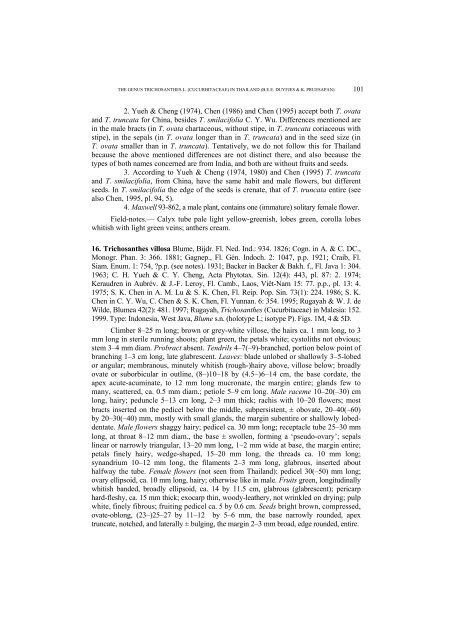The genus Trichosanthes L. (Cucurbitaceae) in Thailand ...
The genus Trichosanthes L. (Cucurbitaceae) in Thailand ...
The genus Trichosanthes L. (Cucurbitaceae) in Thailand ...
Create successful ePaper yourself
Turn your PDF publications into a flip-book with our unique Google optimized e-Paper software.
THE GENUS TRICHOSANTHES L. (CUCURBITACEAE) IN THAILAND (B.E.E. DUYFJES & K. PRUESAPAN) 101<br />
2. Yueh & Cheng (1974), Chen (1986) and Chen (1995) accept both T. ovata<br />
and T. truncata for Ch<strong>in</strong>a, besides T. smilacifolia C. Y. Wu. Differences mentioned are<br />
<strong>in</strong> the male bracts (<strong>in</strong> T. ovata chartaceous, without stipe, <strong>in</strong> T. truncata coriaceous with<br />
stipe), <strong>in</strong> the sepals (<strong>in</strong> T. ovata longer than <strong>in</strong> T. truncata) and <strong>in</strong> the seed size (<strong>in</strong><br />
T. ovata smaller than <strong>in</strong> T. truncata). Tentatively, we do not follow this for <strong>Thailand</strong><br />
because the above mentioned differences are not dist<strong>in</strong>ct there, and also because the<br />
types of both names concerned are from India, and both are without fruits and seeds.<br />
3. Accord<strong>in</strong>g to Yueh & Cheng (1974, 1980) and Chen (1995) T. truncata<br />
and T. smilacifolia, from Ch<strong>in</strong>a, have the same habit and male flowers, but different<br />
seeds. In T. smilacifolia the edge of the seeds is crenate, that of T. truncata entire (see<br />
also Chen, 1995, pl. 94, 5).<br />
4. Maxwell 93-862, a male plant, conta<strong>in</strong>s one (immature) solitary female flower.<br />
Field-notes.— Calyx tube pale light yellow-greenish, lobes green, corolla lobes<br />
whitish with light green ve<strong>in</strong>s; anthers cream.<br />
16. <strong>Trichosanthes</strong> villosa Blume, Bijdr. Fl. Ned. Ind.: 934. 1826; Cogn. <strong>in</strong> A. & C. DC.,<br />
Monogr. Phan. 3: 366. 1881; Gagnep., Fl. Gén. Indoch. 2: 1047, p.p. 1921; Craib, Fl.<br />
Siam. Enum. 1: 754, ?p.p. (see notes). 1931; Backer <strong>in</strong> Backer & Bakh. f., Fl. Java 1: 304.<br />
1963; C. H. Yueh & C. Y. Cheng, Acta Phytotax. S<strong>in</strong>. 12(4): 443, pl. 87: 2. 1974;<br />
Keraudren <strong>in</strong> Aubrév. & J.-F. Leroy, Fl. Camb., Laos, Viêt-Nam 15: 77. p.p., pl. 13: 4.<br />
1975; S. K. Chen <strong>in</strong> A. M. Lu & S. K. Chen, Fl. Reip. Pop. S<strong>in</strong>. 73(1): 224. 1986; S. K.<br />
Chen <strong>in</strong> C. Y. Wu, C. Chen & S. K. Chen, Fl. Yunnan. 6: 354. 1995; Rugayah & W. J. de<br />
Wilde, Blumea 42(2): 481. 1997; Rugayah, <strong>Trichosanthes</strong> (<strong>Cucurbitaceae</strong>) <strong>in</strong> Malesia: 152.<br />
1999. Type: Indonesia, West Java, Blume s.n. (holotype L; isotype P). Figs. 1M, 4 & 5D.<br />
Climber 8–25 m long; brown or grey-white villose, the hairs ca. 1 mm long, to 3<br />
mm long <strong>in</strong> sterile runn<strong>in</strong>g shoots; plant green, the petals white; cystoliths not obvious;<br />
stem 3–4 mm diam. Probract absent. Tendrils 4–7(–9)-branched, portion below po<strong>in</strong>t of<br />
branch<strong>in</strong>g 1–3 cm long, late glabrescent. Leaves: blade unlobed or shallowly 3–5-lobed<br />
or angular; membranous, m<strong>in</strong>utely whitish (rough-)hairy above, villose below; broadly<br />
ovate or suborbicular <strong>in</strong> outl<strong>in</strong>e, (8–)10–18 by (4.5–)6–14 cm, the base cordate, the<br />
apex acute-acum<strong>in</strong>ate, to 12 mm long mucronate, the marg<strong>in</strong> entire; glands few to<br />
many, scattered, ca. 0.5 mm diam.; petiole 5–9 cm long. Male raceme 10–20(–30) cm<br />
long, hairy; peduncle 5–13 cm long, 2–3 mm thick; rachis with 10–20 flowers; most<br />
bracts <strong>in</strong>serted on the pedicel below the middle, subpersistent, ± obovate, 20–40(–60)<br />
by 20–30(–40) mm, mostly with small glands, the marg<strong>in</strong> subentire or shallowly lobeddentate.<br />
Male flowers shaggy hairy; pedicel ca. 30 mm long; receptacle tube 25–30 mm<br />
long, at throat 8–12 mm diam., the base ± swollen, form<strong>in</strong>g a ‘pseudo-ovary’; sepals<br />
l<strong>in</strong>ear or narrowly triangular, 13–20 mm long, 1–2 mm wide at base, the marg<strong>in</strong> entire;<br />
petals f<strong>in</strong>ely hairy, wedge-shaped, 15–20 mm long, the threads ca. 10 mm long;<br />
synandrium 10–12 mm long, the filaments 2–3 mm long, glabrous, <strong>in</strong>serted about<br />
halfway the tube. Female flowers (not seen from <strong>Thailand</strong>): pedicel 30(–50) mm long;<br />
ovary ellipsoid, ca. 10 mm long, hairy; otherwise like <strong>in</strong> male. Fruits green, longitud<strong>in</strong>ally<br />
whitish banded, broadly ellipsoid, ca. 14 by 11.5 cm, glabrous (glabrescent); pericarp<br />
hard-fleshy, ca. 15 mm thick; exocarp th<strong>in</strong>, woody-leathery, not wr<strong>in</strong>kled on dry<strong>in</strong>g; pulp<br />
white, f<strong>in</strong>ely fibrous; fruit<strong>in</strong>g pedicel ca. 5 by 0.6 cm. Seeds bright brown, compressed,<br />
ovate-oblong, (23–)25–27 by 11–12 by 5–6 mm, the base narrowly rounded, apex<br />
truncate, notched, and laterally ± bulg<strong>in</strong>g, the marg<strong>in</strong> 2–3 mm broad, edge rounded, entire.
















